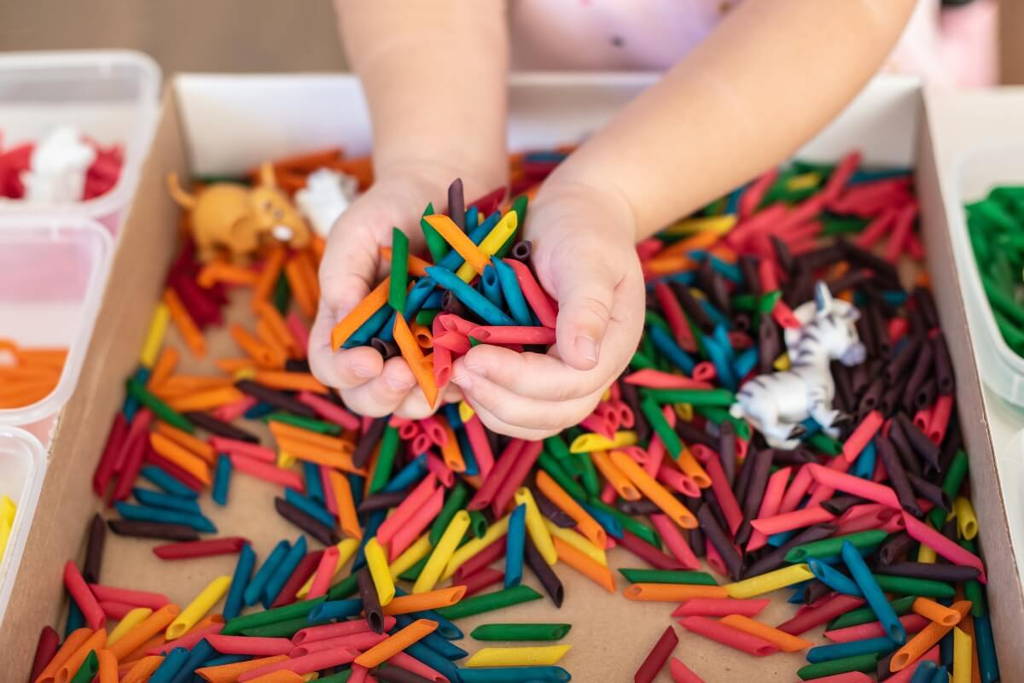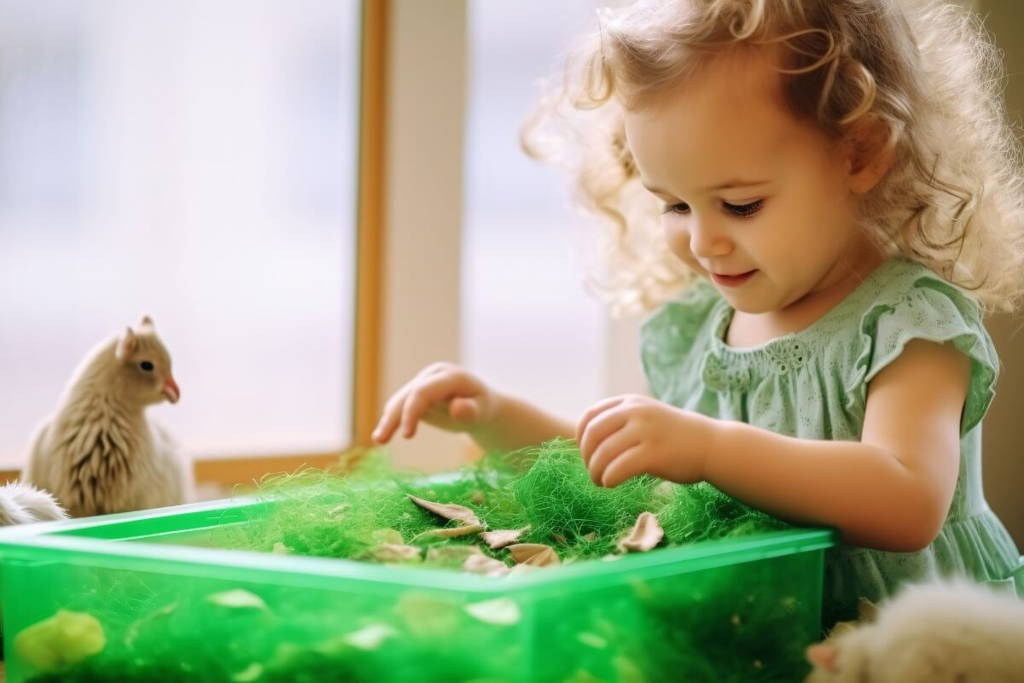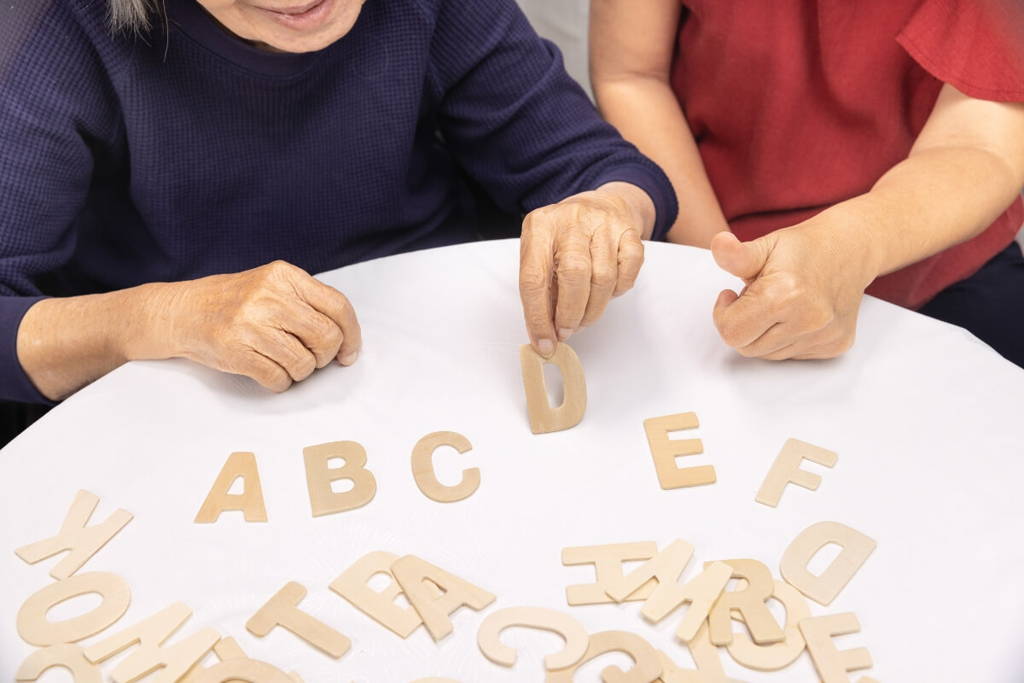
What Is a Montessori Sensory Bin?
Share
There’s nothing quite like sensory bins, those delightful playgrounds for your little one's senses. Imagine a treasure chest overflowing with textures, colors, and sounds, inviting your curious toddler to get in and explore.

These simple yet powerful tools provide a safe space for your child to squish, pour, dig, and experiment to their heart's content. It's a fun and engaging way to learn about different textures, shapes, and even cause-and-effect relationships – all while having a blast!
The Definition of a Sensory Bin
A sensory bin is a container filled with different types of materials that encourage hands-on exploration and stimulate a child's senses. It's a safe and inviting space for little ones to dive in, discover different textures, colors, and sounds, and learn through playful experimentation.
What is The Point of a Sensory Bin?
A good sensory bin provides little ones with a rich sensory experience that helps them develop their sense of touch, sight, and sound.

It also encourages hands-on learning and discovery, fostering curiosity and creativity while promoting fine motor skills, hand-eye coordination, and problem-solving abilities.
Basically, they offer a way to introduce new concepts, words, and senses to kids in a way that’s so fun that they won’t ever get enough.
Importance of Sensory Bins in Early Childhood
Sensory bins aren't just a fun way to keep your little ones entertained; they play a vital role in children’s development. So, let’s take a look at why they’re so important and why you need one for your kiddo as soon as today!
Facilitating Sensory Exploration
Sensory bins provide a rich and stimulating environment for toddlers to explore with all their senses. They can touch, see, hear, and even smell different materials, all of which will foster their sensory development and help them make sense of the world around them.
This hands-on exploration lays the groundwork for future learning and cognitive growth.
Promoting Body Awareness
As your little one digs, scoops, and pours, they're not just having fun – they're also developing a deeper understanding of their own body and how it moves in space. Sensory bins encourage them to explore spatial relationships and develop body awareness through these kinds of interactions.
Supporting Language Development
Sensory bins are a treasure trove of new words and descriptive language. As your child plays, encourage them to talk about what they're experiencing – the smooth pebbles, the rough sand, the squishy water beads. This helps them expand their vocabulary and express their thoughts and ideas.

Enhancing Cognitive Skills
Sensory play isn't just about feeling and touching; it's a workout for the brain, too. As your little one explores their bin and all the goodies inside, they're constantly problem-solving, making predictions, and testing out different ideas. This type of hands-on exploration will help them develop critical thinking skills and lay the foundation for future learning.
Fostering Social Interactions
Sensory bins can be a fantastic way for toddlers to connect and play together. Sharing scoops, taking turns, and collaborating on creations are all part of the fun. These interactions help them develop crucial social skills like cooperation, communication, and empathy.

Developing Motor Skills
Whether they're pouring sand, scooping beans, or picking up tiny objects, sensory bins provide endless opportunities for motor skill development. These activities help strengthen little hand muscles, improve hand-eye coordination, and build dexterity – all essential skills for everyday tasks like holding a pencil, buttoning a shirt, and tying shoes.
Characteristics of Montessori-Style Sensory Experiences
Montessori sensory bins aren't just any old bins filled with random stuff. They're thoughtfully designed to create meaningful learning experiences for your little one. Here are a few key characteristics that set Montessori-style sensory bins apart:
Use of Natural Materials
Montessori emphasizes a connection to the natural world and learning through nature. That's why you'll often find Montessori sensory bins filled with materials like wood, sand, water, and other elements found in nature.

These natural materials provide a rich sensory experience and encourage kids to appreciate the beauty and wonder of the world around them.
For example, you can make a nature-themed sensory bin with some smooth stones, pinecones, acorns, and dried leaves. Then, let your little one explore different textures and colors found in their own backyard.
Purposeful Activities and Learning
In Montessori, there's no such thing as "just playing around." Every item in a sensory bin has a purpose, and each activity is designed to teach a specific skill or concept. Whether it's sorting objects by color, practicing pouring and scooping, or exploring cause-and-effect relationships, there's always a learning opportunity hidden within the fun.
Hands-On Exploration
Montessori education is all about "learning by doing." Sensory bins provide a perfect opportunity for your little ones to get their hands dirty (sometimes literally) and explore the world around them by engaging with the world underneath their little fingerprints.

This hands-on approach fosters independence, curiosity, and a love for learning.
Creating Effective Sensory Bins
Ready to create your own Montessori-inspired sensory bin? Let’s go through some tips to make sure it's both fun and educational for your little one:
Selecting the Right Container
While these playgrounds are as simple as can be, there are still a few things you need to consider while creating a sensory bin.

As you can see, the right container is half the job here. If you pick something that’s sturdy, wide, and accessible for your kid, you’ve done great. Also, if you need any inspiration, check our guide on creating a covered sensory bin.
Choosing Appropriate Fillers
Fillers matter, so make sure to use a mix of textures, colors, and even scents to stimulate your child's senses. Raid your containers and take out rice, dry beans, and pasta. Or even go out into your backyard and gather up some natural materials like leaves, acorns, and pinecones.
Of course, make sure the fillers are safe and non-harmful for your child's age and that you don’t have any small objects that could be choking hazards. And it doesn’t even have to be anything too complicated; you can even make a rice and water sensory bin your little one would love.

Another great way you can make your sensory bins exciting for your little one is to choose a theme and all kinds of fillers that fit with it. For example, you can make rice and water sensory bins with some white rice and water bottles on the site. Don’t forget to put spoons, cups, or even wooden forks so that your kid can play for hours.
And finally, we can’t forget about the cleanup. Make sure to choose fillers that would be easy to clean up if your little one spills something, as they inevitably will while having fun. You can also use a large sheet or tablecloth under the bin for added protection.
Incorporating Thematic Elements
Sensory bins become magical worlds of exploration when you add a touch of theme. This is something where you can let your imagination run wild with your child's interests guiding you.
Do they love dinosaurs? Bury some toy dinos in the sand and let them make their own prehistoric world. Here’s a cool guide on how to create a dinosaur sensory bin.
Are they fascinated by farm animals? Fill the bin with dried corn kernels, hay, and miniature farm figurines for hours of imaginative play. We like to do it this way - Building a farm sensory bin.
Or perhaps they're captivated by the ocean? Create an underwater adventure with blue water beads, seashells, and ocean animal figurines. Again, we can help - Building an ocean sensory bin.

Themed bins spark imagination and create endless opportunities for learning and play. They're also a fantastic way to introduce new vocabulary and concepts. You can even celebrate special occasions by crafting a Halloween sensory bin with spooky black beans and toy spiders, or try building a Christmas sensory bin with sparkly ornaments and miniature trees.
Let’s not forget one of the most beloved holidays - Thanksgiving. There are so many things you can do here, so we recommend you check out our guide on how to create a Thanksgiving sensory bin.
Ensuring Safety and Accessibility
We all love good fun, but we also need to understand how important it is for playtime to be always safe. When you’re picking out the materials for your sensory bin, make sure they’re non-harmful, age-appropriate, and don’t have any small parts.
And, of course, you need to ensure your kiddo can reach the sensory bin. That’s why you should put it in a place where they can easily reach it. This encourages independence and allows them to explore at their own pace.
But of course, you should never let them play alone. While sensory bins are generally safe, it's always a good idea to supervise your child during playtime, especially if you have younger toddlers.
Practical Themes for Montessori Sensory Bins
Montessori sensory bins can be tailored to a variety of themes, sparking your child's curiosity and encouraging them to explore different concepts and interests.

So let’s go over some themes, and you can see what inspires you:
Nature-Themed Bins
Why not bring the outdoors in with a nature-themed sensory bin?
Fill it with natural materials like smooth stones and pebbles, pinecones and acorns, dried leaves and flowers, or even some twigs and bark. This is especially fun in autumn when you create a colorful and crunchy fall sensory bin full of dried leaves of various changing colors.
Also, make sure you check out our guide on how to create a fall sensory bin.
Encourage your child to explore the different textures, colors, and shapes. You can also add magnifying glasses, tweezers, or small shovels to enhance their exploration and discovery.
Seasonal Bins
Celebrate the changing seasons with sensory bins that reflect the unique sights, sounds, and textures of each time of year.
You can create your very own winter wonderland by crafting a winter sensory bin. All you have to do is fill a bin with fake snow, sparkly ornaments, miniature Christmas trees, and jingle bells.

If you want to add a touch of spring to your child’s playtime, learn how to create a Spring sensory bin.
And if your kiddo loves Easter (who doesn't?), you can start crafting an Easter sensory bin with eggs, little rabbit toys, and all sorts of colorful paper.
Everyday Household Items
You don't need fancy materials to create a fun and engaging sensory bin. Look around your house for everyday items that can be repurposed for sensory play.
Some ideas include:
- Dry pasta (various shapes and sizes)
- Rice or beans
- Measuring cups and spoons
- Wooden spoons and spatulas
- Pom-poms or cotton balls
- Empty spice containers or egg cartons
Remember, the key is to choose themes and materials that spark your child's interest and encourage open-ended exploration. Let their curiosity guide you as you create unique and engaging sensory experiences.
The Difference Between Sensory Bins and Sensory Tables
While both sensory bins and sensory tables offer fantastic opportunities for hands-on exploration, they have some key differences that might influence your choice.
-
Sensory bins: These are typically smaller, portable containers filled with all kinds of sensory materials. They're perfect for individual or small group play and can be easily stored away when not in use.

-
Sensory tables: These are larger, often table-height structures designed for multiple children to play and explore together. They offer a more expansive space for collaborative activities and can accommodate larger quantities of sensory materials.

Now, if you’re already set on the idea to create a sensory table, you should do it properly. Luckily, we have a complete guide on how to create and use sensory tables - check it out.
Insights from Montessori Educators
Montessori educators have a lot of experience and knowledge when it comes to sensory play, so if you really want to get the most out of your sensory bin, you will want to listen to their advice.
Advice on Age-Appropriate Sensory Bin Topics and Materials
If you have a 1-year-old, you should focus on simple sensory experiences with safe, non-toxic materials or soft fabrics. You can check out our guide on sensory bins for 1-year-olds to get some safe and fun ideas for a sensory bin.
And if you have a 2-year-old, you can introduce slightly more complex materials and themes, like water play, sand play, or themed bins with some figurines. Encourage your little one to explore, work on problem-solving, and develop their language skills.
There are all sorts of ideas you can go with here - make sure to check our guide on how to create a sensory bin for 2-year-olds.

Remember to always supervise your child during sensory play and adjust the materials and activities based on their individual development and interests.
Best Practices from Experienced Teachers
Montessori teachers have spent years watching little ones light up with joy as they explore sensory bins. And, naturally, they've picked up some awesome tips and tricks along the way. Let's peek into their classrooms and see how the pros create magical sensory experiences for their students.
- Rotate the bins: Keep things fresh and exciting by regularly rotating the sensory bins you offer. This helps maintain your child's interest and encourages them to explore new materials and themes.
-
Incorporate learning objectives: Choose materials and activities that align with your child's developmental goals. Focus on specific skills like fine motor development, color recognition, or sorting and matching.
- Observe and engage: Pay attention to how your child interacts with the sensory bin. What materials do they gravitate towards? What activities do they enjoy the most? Use these observations to guide your future bin creations and provide additional support or challenges as needed.
Sensory bins are a cornerstone of Montessori education, offering young kiddos a world of exploration and learning. These hands-on experiences foster sensory development, cognitive growth, motor skills, and social interaction, all while sparking curiosity and a love for the natural world.
And now, we'd love to hear from you! What's your favorite sensory bin theme or material? Share your experiences and ideas by writing to us at info@karolinakids.com.
And remember to subscribe to our blog for ongoing insights into Montessori practices and inspiring activities for your little ones.
